
|   |

|   |
 e-mail: sunilkothari1933@gmail.com Rangayan Festival of Art and Literature 2018 November 30, 2018 Many years ago, when I had met Sattriya dancer Sharodi Saikia at Guwhati at Indira PP Bora's residence, I was pleased to learn that her contribution to revival of Sattriya dance was similar to revival of Odissi by Sanjukta Panigrahi. Very few women had taken to learning Sattriya dance, which was practiced by the monks in Sattras. Raseshwar Saikia was the first Adhyapak/Guru who after leaving Kamalabari Sattra and adopting grihasthashram (marriage), took a bold step to give training in Sattriya dances to few young girls - among them were Sharodi Saikia, Indira PP Bora and others. 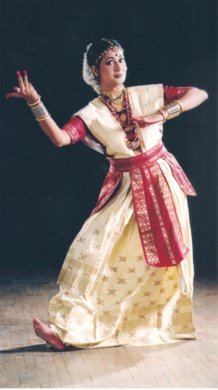 Sharodi Saikia Hailing from a distinguished family, Sharodi had been performing and studying Sattriya dance with complete devotion. She had performed in Indonesia when she had gone with the President of India, Fakhruddin Ali Ahmed. She had good academic career and had been serving in Department of Education. The dance practice was regular. When Sattriya received recognition as the eighth classical dance form in 2000, Sharodi was already a leading performer. She established Rangayan, an academy of Dance, Theatre and Music in 2002 as the cultural wing of the North-East Foundation, which was established in 1996. Its objective was to create a platform for intellectual inquiry into the society and affairs of the North-Eastern region of India in an expansive framing at the National, South-East Asian and Global perspective. The Foundation works towards organizing, sponsoring and stimulating in-depth studies in various spheres of the North-East that includes history, ethnography, demography, and archaeology to provide a platform for a wide and meaningful discourse on different issues affecting the people of the North East. The Foundation also publishes a quarterly journal 'Yaatra,' the Journal of Assamese Literature and Culture. Since its inception, on 24th October every year, Rangayan has been presenting dance and music evenings with its alumna, who have had their formal debut on stage, Ranga Pravesh, as well as students studying arts - events like Ranga Vaibhav, Ranga Abhinava, Ranga Sangam, and Ranga Kriti in which artists of national and international repute have taken part. Rangayan concentrates on Sattriya dance training. It provides opportunities to up and coming artists with unified group approach, essential to chart a new path holding interactive sessions for a rounded development. The existing syllabi of Sangeet Sattra, Sattra Mahasabha finalized by the experts are followed at Rangayan. The training is given 5 days a week, with focus on interdisciplinary skills, grace and motivation. The component of 6 months duration and completion of 3 year course equips the student to perform professionally. The study of philosophy, yoga, music, stage craft, lighting, teaching methodology, make-up skills, costume designing are part of preparation for the students. Rangayan has in collaboration with Srimanta Sankaradeva Kalakshetra held workshops on Angika in Sattriya. They have released a book 'The Music and the Musical Instruments of North Eastern India' written by Dr. D.R. Barthakur, renowned musician of the state and member of the Advisory Board of Rangayan. Rangayan also has a repertory with up and coming young dancers, disciples of Adhyapakas in the field of Sattriya dance. This year, Rangayan embarked upon the ambitious Festival of Art and Literature. Recognizing that there is inter-connection between the visual, scribal and performing arts, not only in North East region but also globally, with the collaboration of Asom Sahitya Sabha, Sahitya Akademi, and Guwahati Artists' Guild the inaugural edition of RALF (Rangayan Art Literature Festival) was launched. From New Delhi, the founding members of Kri Foundation, Dr. Arshiya Sethi and Bharatanatyam dancer Rama Vaidyanathan offered a Bharatanatyam recital inspired by the movements and metaphor of birds in a joint artistic collaboration. 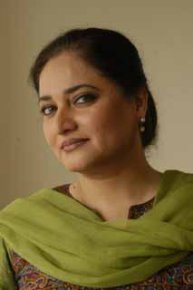 Dr. Arshiya Sethi 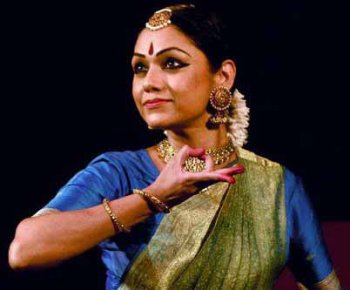 Rama Vaidyanathan Along with the introduction of the process of bird watching and its brief history Arshiya drew attention with video projection of unusual species of birds, their migration, visit to India flying from thousands of miles away from different continents. It added to the pleasure of watching the performance as for different numbers she gave references of birds in mythology - for instance rooster, linking it with Divya Prabandha, and references to Garuda as Vahana of Lord Vishnu. In another item, Rama brought the movements of the birds alive. The cooing of the bird, sitting on the shoulder of a nayika, she beseeching the bird to go unto her Lord to convey her message, Garuda flying, covering the space, suggested by netrabhinaya - eyes moving over and upward suggesting space - were imaginative touches. In Vrikshanjali, the poem translated in Sanskrit, the philosophy of how a tree with deep roots supports the trunk, the sap helping the leaves and flowers to bloom and the flowers are used for worship of Gods, birds flying away from the branches and nest of the tree, mother feeding the little bird, and encouraging the little one to fly off et al were pregnant with meaning. The one inspired by Hamsa, had another wonderful association - so ham, so ham when repeated again and again becomes Hamsa. Hamsa is goose or swan? References to Hamsa suggest the bird as a messenger between Damayanti and Nala, whereas one notices in a sculpture at Khajuraho, where a nayika is gathering her wet hair, and drops fall on the floor, a bird is seen collecting the drops like pearls were excellent examples. Hamsa is also credited with discriminating between milk and water, known as 'nirakshiraviveka'. And one is also led to remembering Ramakrishna Paramahamsa making a dance number so rich. The Upanishadic thought to rise above ego, a journey of soul pushing ego out and seeking liberation was interwoven in Tillana. The joyous abandonment with movements brought down the house. The performance by Rama, with enlightening discourse by Arshiya was a sheer delight. Both of them deserve congratulations for exploring the Bharatanatyam form. Next day, the monks from Uttara Kamalabari Sattra presented Gayan Bayan. Their entering on the stage in circular formation, the cymbal players and drummers dressed in white costumes with typical pugrees, and the proclamation singing praise of Ram and Hari filled the auditorium with a feeling of devotion. Sattriya dances are deeply imbued with bhakti. They executed various talas, with hastas, playing on drums alternatively on either side and resulting in a crescendo. The Bayan performers were Krishna Hazarika Bayan, Bhaskar Saikia Bayan, Dinanath Boruah Bayan and Deepak Boruah Bayan and Gayan artists were Baluram Bargayan, Pabirta Saikia Gayan, Debananda Borah Gayan and Santanu Gayan. Their performance was flawless, evoking devotional mood. Anjana Moyee Saikia is a versatile dancer trained in both Odissi (early training in Odissi under Gorima Hazarika and later under Protima Bedi and Guru Kelucharan Mohapatra) and Sattriya (under Ghanakanta Bora); she is also a stage actor. She founded her dance institution Darpan Dance Akademi offering training in Odissi. Anjana chose to present Pallavi in Megha raga, choreographed by Ratikant Mohapatra. She has a commanding stage presence and executes movements in an unhurried manner allowing the resolutions to end perfectly. The sculptural movements, the hallmark of Odissi, sit well on her body. Performing to the recitation of ukutas and solfa -swaras, she danced with ease. The next number was Devi Stuti choreographed by Pankaj Charan Das. The refrain Jaya Bhagavati Devi namo varade, followed with praise of the Goddess who killed the demons Shumbha and Nishumbha, holding the skulls in her hands, were projected with poses known for annihilating the demons. Her body grew in stature as Devi attacking the demons. The Goddess with eyes compared to sun and moon, worshiped by Bhairav, rode majestically. Ya Devi sarva bhuteshu shloka was included for enhancing the temperament of the Goddess when she kills demon Mahisha and is epitome of energy, Shakti rupen samsthita, which befitted the mood. Lucknow gharana Kathak exponent petite Aligunjan Kalita Mudiar is a well known dancer from Assam. After learning from Marami Medhi, she took further training from Surendra Saikia for more than twenty five years, and received diploma in vocal music from Bhatkhande Sangeet Vidyapitha, Lucknow. Full of beans, with sparkling movements, graceful and articulating Lucknow gharana's khoobsurati, Aligunjan performed Ganesh Vandana using Kavit and shloka Vakrtunda Mahakaya followed by Pratham sumiran Shri Ganesha, Gauri suta, Lambodara, Bhuja vishal, creating iconography of Lord Ganapati. She performed traditional Kathak in madhya laya trital and also in druta laya and executed uthan, tatkar and thaat, the graceful way of standing, using micro movements of eyebrows and wrists, which were full of old world charm of Kathak. Her chakkars were skilful, coming pat on the final beat. Her dance has the quicksilver quality and joyous abandon. The thumri for abhinaya saw her in mood of despair as she went on describing how lonely a nayika felt without Krishna, looking all around to see if he returns. She could not sleep, nor could she pass the night, and announced that she would go mad if Krishna does not turn up. Aligunjan has an expressive face and registers emotions in an engaging manner. She seemed to be in hurry to complete her recital which was a pity. She did well within given time. 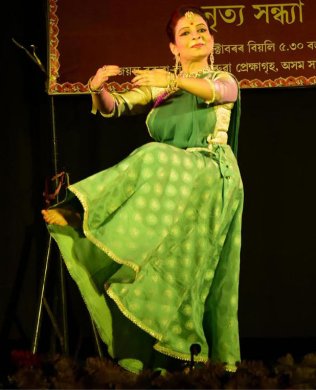 Aligunjan Kalita 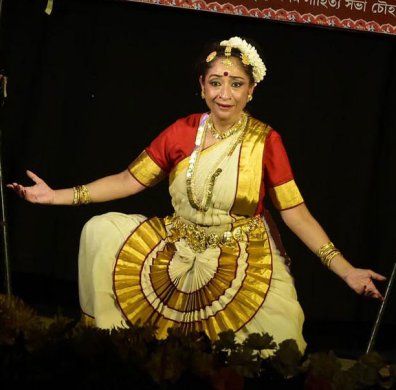 Priyadarshini Ghosh From Kolkata, Priyadarshini Ghosh presented Mohiniattam. An accomplished dancer, she received training under Thankamani Kutty and moved to Kerala to study under legendary Kalyani Kutty Amma. She also studied abhinaya under Kalanidhi Naryanan and for some time took training in Seraikella Chhau dances. She has taught at the Brown University at Theatre Arts and Performance Studies as a visiting faculty. She also was at Duke University as a choreographer for American Dance Festival. She is working on contemplative aspect of a performance, basing it on Yoga practice. She is working with Kalamandalam Rajneesh Chakyar for understanding principles of abhinaya of Koodiyattam and with Guru Nirmala Panikkar for Mohiniattam. She chose to present Saraswati prayer composed by Kavalam Panicker set to champada tala and in raga Vrindavani Sarang. The description dealt with marvelous deeds of Ganapati Adbhuta Charitre, and offering salutations to Veenapani Saraswati mathe. Adi Shankaracharya's composition set to Sopana music was descriptive and eulogized Goddess Parvati's divine beauty and deeds. Namah Shivabhyam, Nava youvana, sundari, Raka mukhaambuja similar in beauty of the moon, charumukhamandala, the face with indescribable beauty and so on. The stamp of Sopana music was evident and the typical Mohiniattam movements merged with the music. In the Swati Tirunal song Chaliye kunjan mo, tum ham mila Shyam Hari in Yamuna Kalyani, Priyadarshini displayed nayika's joy describing natural beauty of Brindavan, flowing Yamuna river, cuckoo's sweet songs, dancing with friends, relishing the nectar of kiss as the bee relishes juice of flowers, the pleasure of being with Krishna. This particular song has a distinct appeal and Priyadarshini performed joyously. The finale was enthralling with the magic of Manipuri dances. The three Pung players stood with their heads lowered, wearing pugrees, in mood of payer and struck the drums, creating various patterns of talas, special to Manipuri music. The tempo increased and they danced in frenzy, and in unison their pugrees feel on the floor. The effect was powerful that the audience burst out clapping. When they dance taking aerial moves holding drums in hand and landing on beat, the impact is always magical. One has been watching pung cholom for ages and its impact continues to enchant us. K. Jadu Singh, L. Kala Singh and L. Shyamson Singh are well trained pung players who never fail in entertaining the audiences. 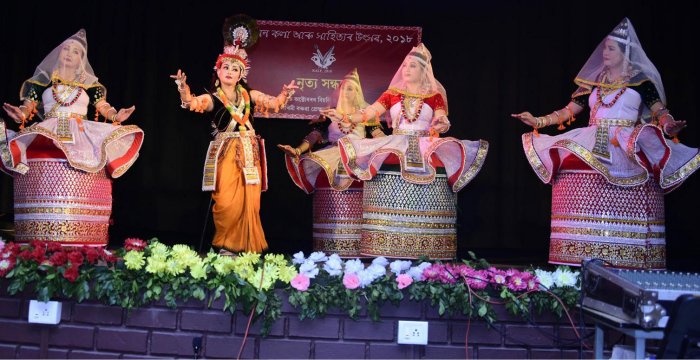 JNMDA The Rangayan festival ended on a festive mood. One always marvels at the various dance forms India boasts of. No other country in the world has eight classical dance forms. The selection was ideal and brevity was the soul of the performers. One looks forward to receiving a bonanza of literature, paintings, music and dance in coming years.  Dr. Sunil Kothari is a dance historian, scholar, author and critic, Padma Shri awardee and fellow, Sangeet Natak Akademi. Dance Critics' Association, New York, has honoured him with Lifetime Achievement award. Post your comments Please provide your name and email id when you use the Anonymous profile in the blog to post a comment. All appropriate comments posted with name & email id in the blog will also be featured in the site. |